Study on the Influence of Chord Length and Frequency of Hydrofoil Device on the Discharge Characteristics of Floating Matter in Raceway Aquaculture
Abstract
1. Introduction
2. Physical Model
2.1. Aquaculture Raceway Model
2.2. Hydrofoil Motion Model
2.3. Performance Parameters
3. Numerical Method
3.1. Turbulence Model and DPM Model
3.2. Mesh Generation and Solving Settings
3.3. Numerical Simulation of Particle Dispersal Strategy
3.4. Grid Independence Validation
3.5. Method Validation
4. Results and Discussion
4.1. Effect of Chord Length and Frequency on the Flow Field
4.1.1. Effect of Different Frequencies and Chord Lengths on the Flow Field
4.1.2. The Impact of Chord Length on Flow Field Structure
4.2. Effect of Chord Length and Frequency on Particulate Discharge Performance
4.2.1. Distribution Characteristics of Floating Particles in Raceway Aquaculture Driven by Hydrofoil Device
4.2.2. Effect of Frequency and Chord Length on Particle Discharge Rate
5. Conclusions
- In the floating particle discharge of raceway aquaculture, when the chord length and motion frequency of the oscillating hydrofoil device are 0.1 W and 1.0 Hz, respectively, the anti-Karman vortex street generated by the hydrofoil device is less affected by the wall, the uniformity of the flow field is higher, and the final floating particle discharge rate reaches 99.09%.
- Changing the chord length of the hydrofoils can effectively improve the recirculation problems in the flow field, and enhance the uniformity and flow performance of the flow field, with the best uniformity at a chord length of 0.1 W; and superior flow performance at a chord length of 0.2 W.
- The frequency has less impact on the structure of the flow field, but increasing the frequency can improve the flow performance of the flow field. On average, every 0.1 Hz increase in motion frequency can improve the outlet average velocity by 19.42%, with the highest outlet average velocity of 1.042 m/s at chord length c = 0.2 W and frequency f = 1 Hz.
Author Contributions
Funding
Data Availability Statement
Acknowledgments
Conflicts of Interest
References
- Brown, T.W.; Chappell, J.A.; Boyd, C.E. A commercial-scale, in-pond raceway system for Ictalurid catfish production. Aquac. Eng. 2011, 44, 72–79. [Google Scholar] [CrossRef]
- Brown, T.W.; Boyd, C.E.; Chappell, J.A. Organic carbon and dissolved oxygen budgets for a commercial-size, in-pond raceway system. J. World Aquac. Soc. 2015, 46, 539–548. [Google Scholar] [CrossRef]
- Zhang, Z.D.; Xiao, Y.H.; Fan, Y.H.; Ma, W.J.; Zhou, F. A brief analysis of the development status of the pond engineering recirculating water aquaculture model. China Fish. 2019, 5, 34–37. [Google Scholar]
- Jia, L.; Pan, Y.; Liu, S. One new culture pattern of America: Running water of internal recycle in pond. China Fish. 2011, 1, 40–42. [Google Scholar] [CrossRef]
- Martins, C.I.M.; Eding, E.H.; Verdegem, M.C.J.; Heinsbroek, L.T.N.; Schneider, O.; Blancheton, J.P.; Roque d’Orbcastel, E.; Verreth, J.A.J. New developments in recirculating aquaculture systems in Europe: A perspective on environmental sustainability. Aquac. Eng. 2010, 43, 83–93. [Google Scholar] [CrossRef]
- He, Y.M.; Zhang, T.H.; Chen, W.Y.; Zhang, Z.B. Factors and countermeasures affecting the effect of tank collection and sewage discharge in the industrial ecological aquaculture system of ponds. Sci. Fish Farming 2016, 6, 2–3. [Google Scholar] [CrossRef]
- Gesto, M.; Gregersen, K.J.; Pedersen, L.F. Effects of ozonation and foam fractionation on rainbow trout condition and physiology in a small-scale freshwater recirculation aquaculture system. Aquaculture 2022, 557, 738312. [Google Scholar] [CrossRef]
- Timmons, M.B.; Ebeling, J.E. Recirculating Aquaculture, 2nd ed.; Cayuga Aqua Ventures NRAC Publication: New York, NY, USA, 2010; p. 177. [Google Scholar]
- Song, D.J.; Li, Z.Y.; Lu, W.; Ma, S.S.; Xue, Z.R.; Qu, K.M.; Chen, Q.S.; Wang, B.X. Study on a new type of high efficiency filter. Mar. Fish. Res. 2003, 4, 51–56. [Google Scholar] [CrossRef]
- An, X.L.; Zhou, Q.X. Progress in study of bioremediation for aquaculture self-polluted water bodies. Chin. J. Environ. Eng. 2006, 7, 1–6. [Google Scholar] [CrossRef]
- Li, W.; Cheng, X.; Xie, J.; Wang, Z.; Yu, D. Hydrodynamics of an in-pond raceway system with an aeration plug-flow device for application in aquaculture: An experimental study. R. Soc. Open Sci. 2019, 6, 182061. [Google Scholar] [CrossRef] [PubMed]
- Wang, X.; Cui, K.; Li, H.Y.; Jiang, Y.Y.; He, J.X.; Zhang, J. Numerical simulation of flow field characteristics for aquaculture raceway and analysis of solid phase distribution in waste settling zone. Trans. Chin. Soc. Agric. Eng. 2019, 35, 220–227. [Google Scholar] [CrossRef]
- Wu, Y.F.; Zhang, Q.J.; Gui, F.K.; Zhang, Z.K.; Chen, Q.L.; Feng, D.J. Waste collection performance of the octagonal aquaculture tank driven by submersible flow propellers. J. Fish. China 2024, 48, 132–144. [Google Scholar] [CrossRef]
- Yu, Z.Y.; Xiong, B.; Liu, W.; Jiang, B.; Gao, J.; Zhao, Q.; Yang, Y.J. Analysis of the types and adaptability of aerators. Farm Mach. 2019, 2, 97–99. [Google Scholar] [CrossRef]
- Wei, W.; Wei, J.W.; Wang, D.Q.; Geng, L.L. Study on the Modes of Aeration and Push Flow of Oxidation Ditch Process. Water Sci. Eng. Technol. 2011, 2, 26–29. [Google Scholar] [CrossRef]
- Hua, E.T.; Chen, W.Q.; Tang, S.W.; Xie, R.S.; Guo, X.M.; Xu, G.H. Water Pushing Flow Characteristics of Flapping Hydrofoil Device in Small River. Trans. Chin. Soc. Agric. Mach. 2022, 53, 154–162. [Google Scholar] [CrossRef]
- He, G.Y.; Zhang, X.; Zhang, S.G. Numerical studies on flows around a flexiblly wiggling hydrofio. Chin. J. Theor. Appl. 2010, 42, 15–22. [Google Scholar]
- Ding, H.; Song, B.W.; Tian, W.L. Exploring Propulsion Performance Analysis of Bionic Flapping Hydrofoil. J. Northwestern Polytech. Univ. 2013, 31, 150–156. [Google Scholar] [CrossRef]
- Zhang, Y.; Yang, F.; Wang, D.; Jiang, X. Numerical investigation of a new three-degree-of-freedom motion trajectory on propulsion performance of flapping foils for UUVs. Ocean Eng. 2021, 224, 108763. [Google Scholar] [CrossRef]
- Cao, Y.H.; Chao, L.M.; Ding, H.; Zhao, H.Y. Propulsive Performance of Complex Flapping Foils. J. Shanghai Jiaotong Univ. 2016, 50, 1228–1232. [Google Scholar] [CrossRef]
- Hua, E.T.; Luo, H.T.; Xie, R.S.; Chen, W.Q.; Tang, S.W.; Su, Z.X. Design and Test of Flapping Hydrofoil Bionic Water Pumping Device. Trans. Chin. Soc. Agric. Mach. 2023, 54, 155–162. [Google Scholar] [CrossRef]
- Hua, E.T. Investigation of the Effect of Pumping Depth and Frequency of Flapping Hydrofoil on Suspended Matter Discharge Characteristics. Machines 2024, 12, 300. [Google Scholar] [CrossRef]
- Jin, W.; Luo, R.B.; Gu, R.B.; Xu, P. A review about pond engineering aquacultural systems. Fish. Mod. 2015, 42, 32–37. [Google Scholar] [CrossRef]
- Xie, O.; Zhu, Q.X.; Jiang, Q.S.; Shen, Y.H. Study on wall effect of near wall swimming of biomimetic robot fish. J. Huazhong Univ. Sci. Technol. (Nat. Sci. Ed.) 2018, 46, 59–63. [Google Scholar] [CrossRef]
- Li, Y.C.; Wang, J.; Chen, J.J. Numerical Investigation of Pitching Foil’s Propulsive Performance with Wall Effect. Nav. Archit. Ocean Eng. 2020, 36, 26–31. [Google Scholar] [CrossRef]
- Techet A, H. Propulsive performance of biologically inspired flapping foils at high Reynolds numbers. J. Exp. Biol. 2008, 211, 274–279. [Google Scholar] [CrossRef] [PubMed]
- Hua, E.T.; Su, Z.X.; Xie, R.S.; Chen, W.Q.; Tang, S.W.; Luo, H.T. Optimization and experimental verification of pivot position of flapping hydrofoil. J. Hydroelectr. Eng. 2023, 42, 128–138. [Google Scholar] [CrossRef]
- Zhou, Y.X.; Liu, H.B.; Hu, W.; Ren, X.Z.; Li, M. A Review: Application and Prospect of Fish Rheotaxis in a Recirculating Aquaculture System. Fish. Sci. 2024, 43, 1–15. [Google Scholar] [CrossRef]
- Venegas, P.A.; Narváez, A.L.; Arriagada, A.E.; Llancaleo, K.A. Hydrodynamic effects of use of eductors (Jet-Mixing Eductor) for water inlet on circular tank fish culture. Aquac. Eng. 2014, 59, 13–22. [Google Scholar] [CrossRef]
- Menter, F.R. Two-equation eddy-viscosity turbulence models for engineering applications. AIAA J. 1994, 32, 1598–1605. [Google Scholar] [CrossRef]
- Könözsy, L. The k-ω shear-stress transport (SST) turbulence model, 6th ed. Fluid Mech. Its Appl. 2019, 120, 57–66. [Google Scholar] [CrossRef]
- Li, F.; Yu, P.; Deng, N.; Li, G.; Wu, X. Numerical analysis of the effect of the non-sinusoidal trajectories on the propulsive performance of a bionic hydrofoil. J. Appl. Fluid Mech. 2022, 15, 917–925. [Google Scholar] [CrossRef]
- Liu, J.J.; Zhang, L.L.; Zhang, Y.P. Particle Size Distribution of Suspended Solids in Cultured Tailwater of Pacific White Shrimp Litopenaeus vannamei. Fish. Sci. 2024, 43, 41–50. [Google Scholar] [CrossRef]
- Li, M. The Length-Width Ratio of Rectangular Arc Angle Aquaculture Tank Impact of Flow Field and Sewage Discharge. Master’s Thesis, Dalian Ocean University, Dalian, China, 2023. [Google Scholar] [CrossRef]
- Zhang, J.H.; Wu, T.; Xu, D.; Gao, Y.P.; Tang, W. Feeding on feces, diets and cage farming sediments of Paralichthys olivaceus by Japanese scallop Patinopecten yessoensis. Prog. Fish. Sci. 2013, 34, 96–102. [Google Scholar] [CrossRef]
- Read, D.A.; Hover, F.S.; Triantafyllou, M.S. Forces on oscillating foils for propulsion and maneuvering. J. Fluids Struct. 2003, 17, 163–183. [Google Scholar] [CrossRef]
- Zhang, J.F.; Liang, J.X.; Qi, H.; Zhang, Q.H. Experimental study on the effect of marine snow on the settling of microplastics in nearshore waters. Oceanol. Limnol. Sin. 2022, 53, 852–860. [Google Scholar] [CrossRef]
- Von Kármán, T. General aerodynamic theory-perfect fluids. Aerodyn. Theory 1935, 2, 346–349. [Google Scholar] [CrossRef]
- Wu, Q.; Huang, B.; Wang, G. Numerical Simulation of Transient Flows around a 3D Pitching Hydrofoil. Adv. Mech. Eng. 2015, 7, 808034. [Google Scholar] [CrossRef]
- Ozdemir, Y.H.; Cosgun, T.; Barlas, B. Wave field generated by finite-span hydrofoils operating beneath a free surface. Brodogr. Int. J. Nav. Archit. Ocean Eng. Res. Dev. 2021, 72, 145–167. [Google Scholar] [CrossRef]
- Green, M.A.; Rowley, C.W.; Smits, A.J. The unsteady three-dimensional wake produced by a trapezoidal pitching panel. J. Fluid Mech. 2011, 685, 117–145. [Google Scholar] [CrossRef]
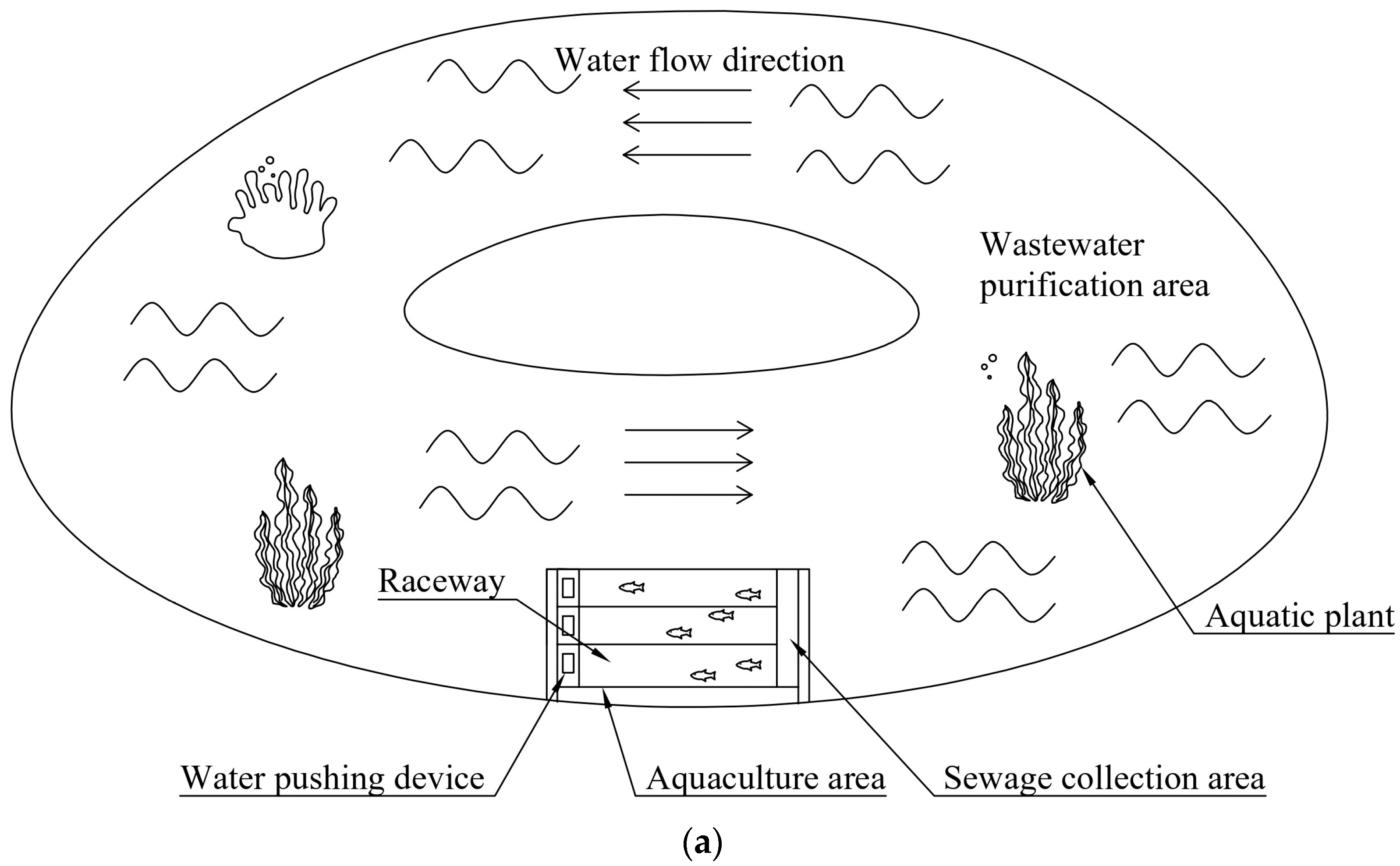

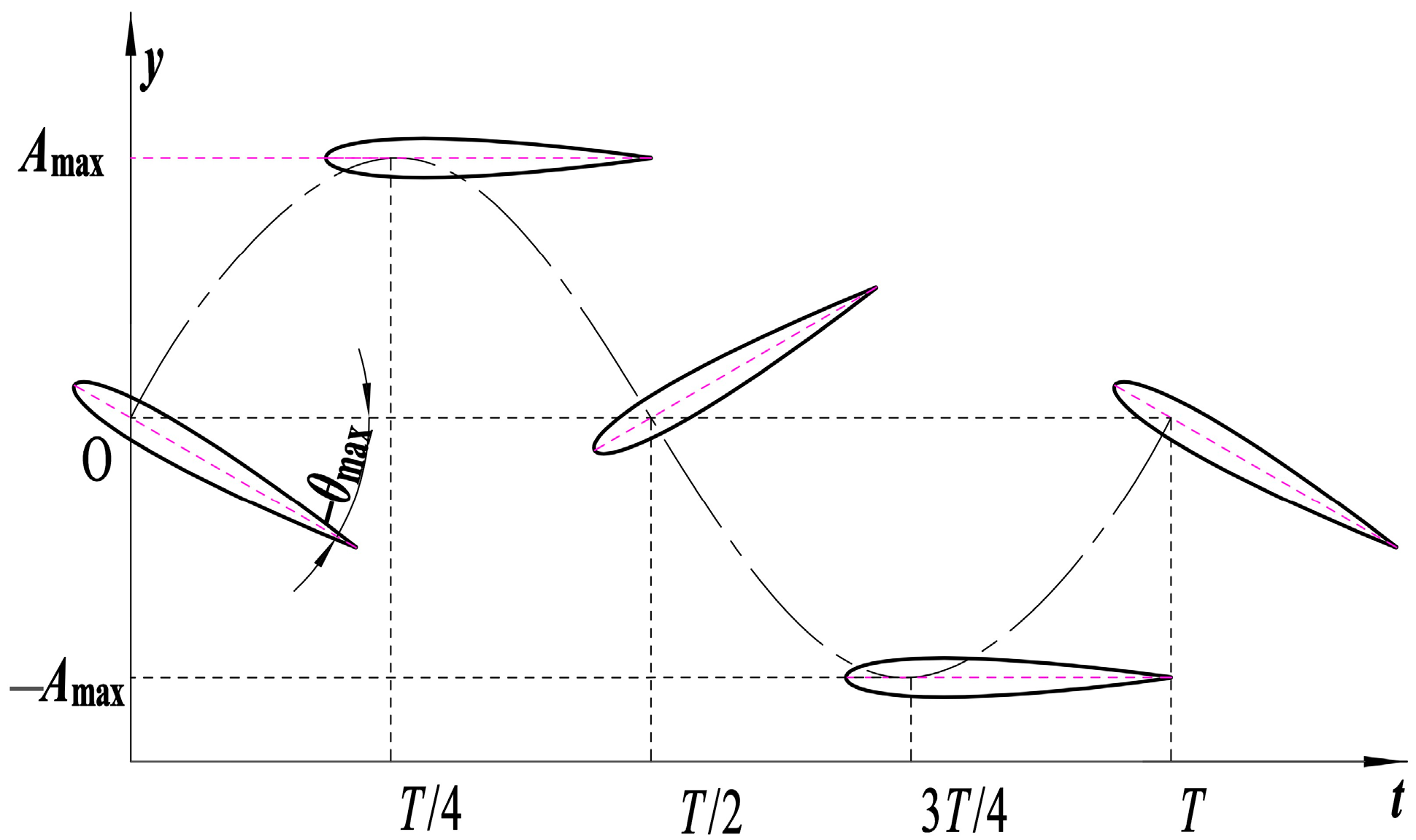
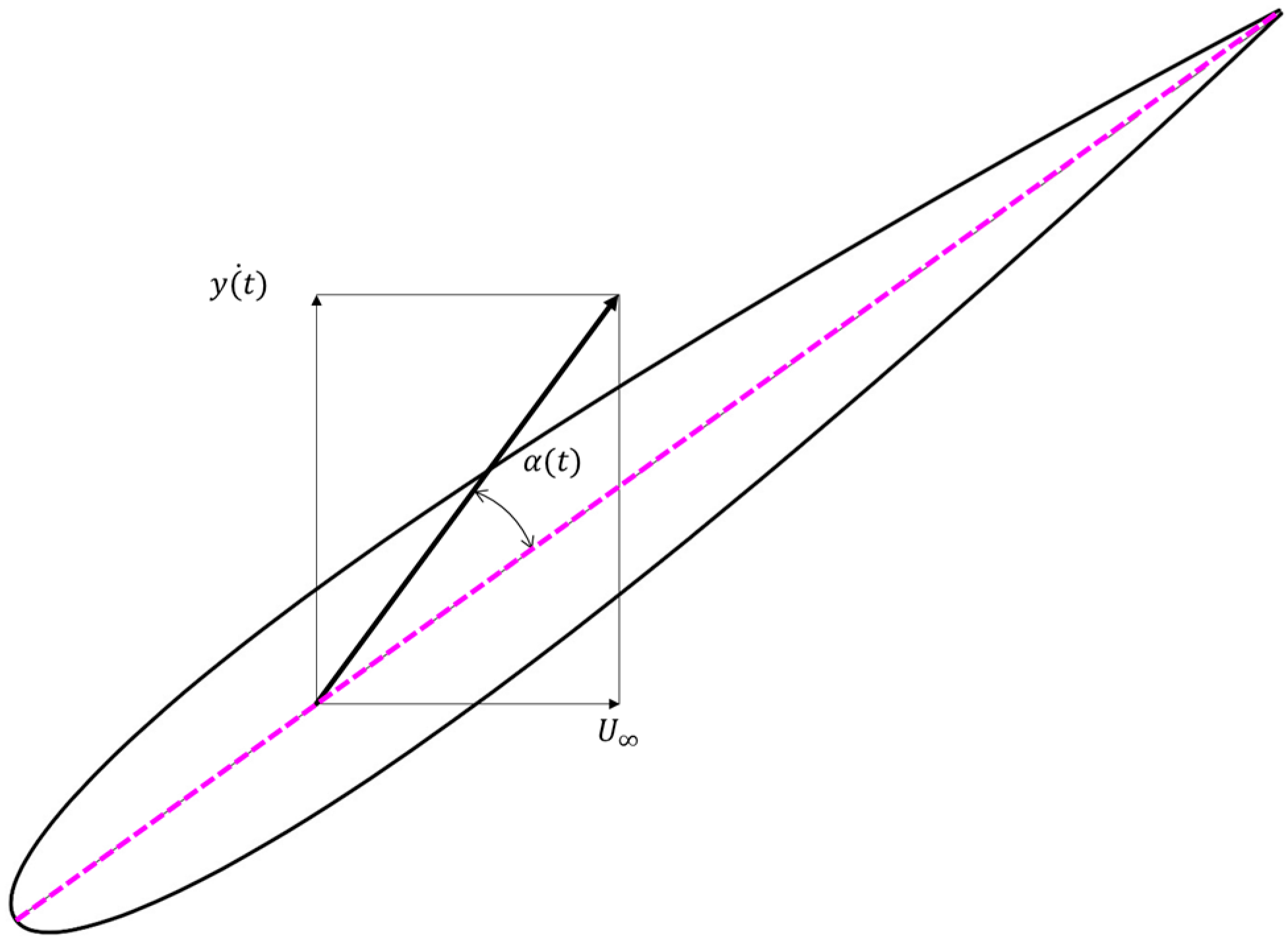
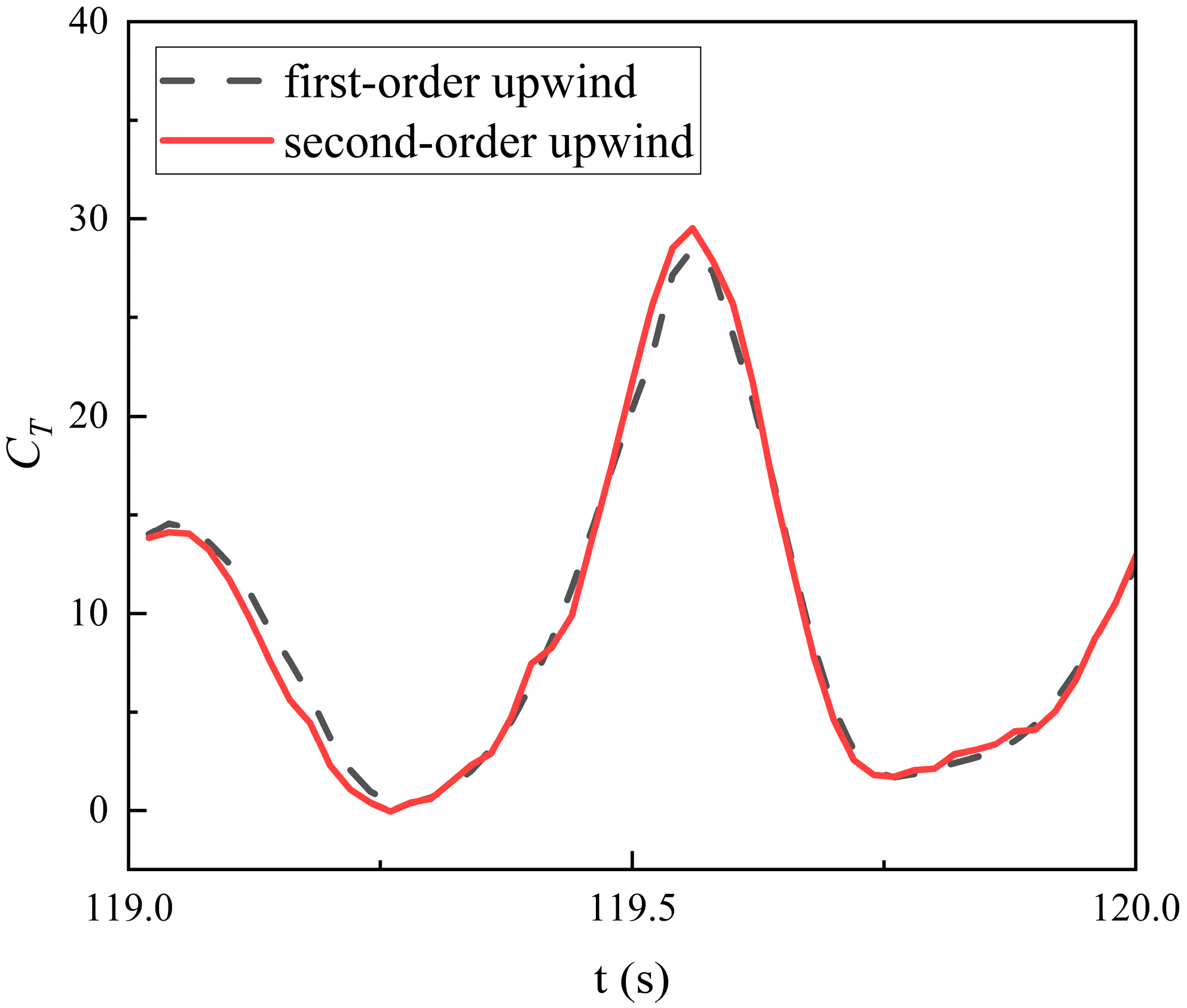
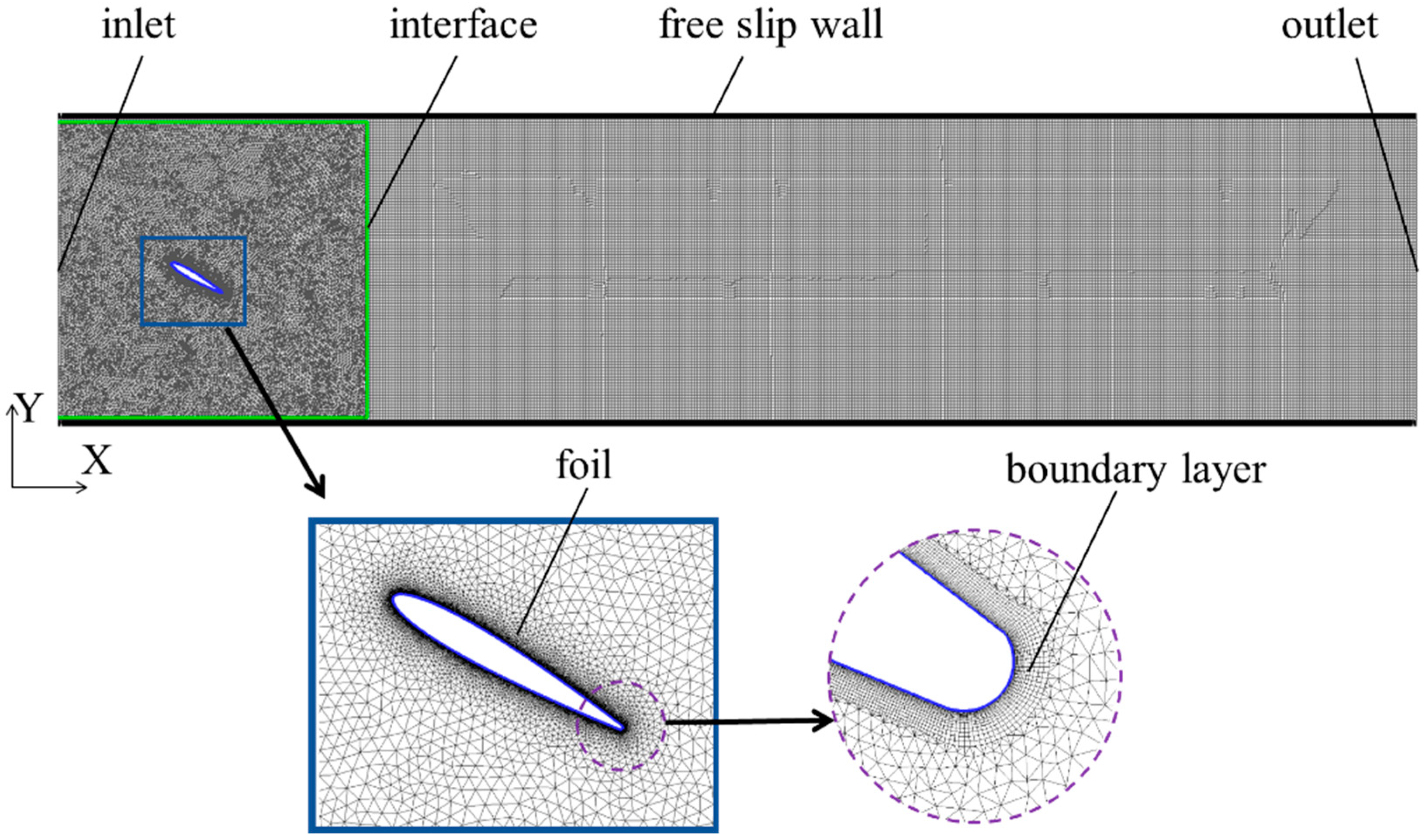
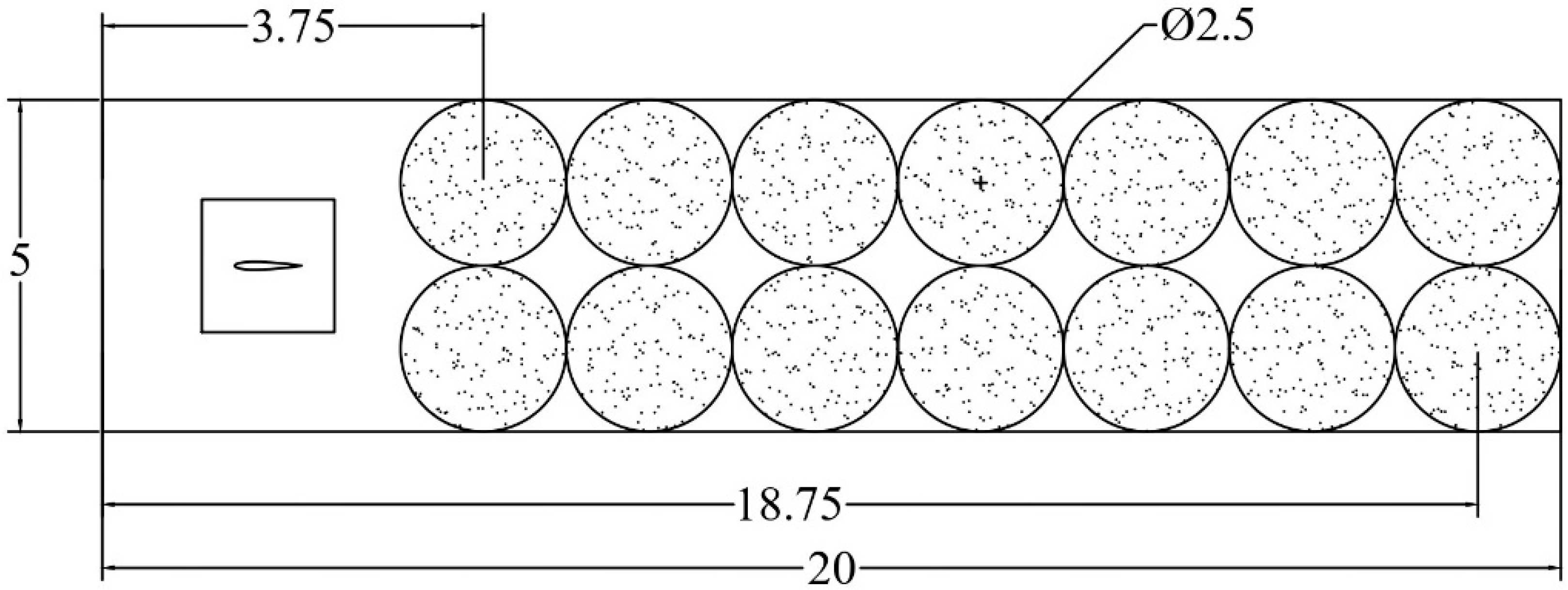
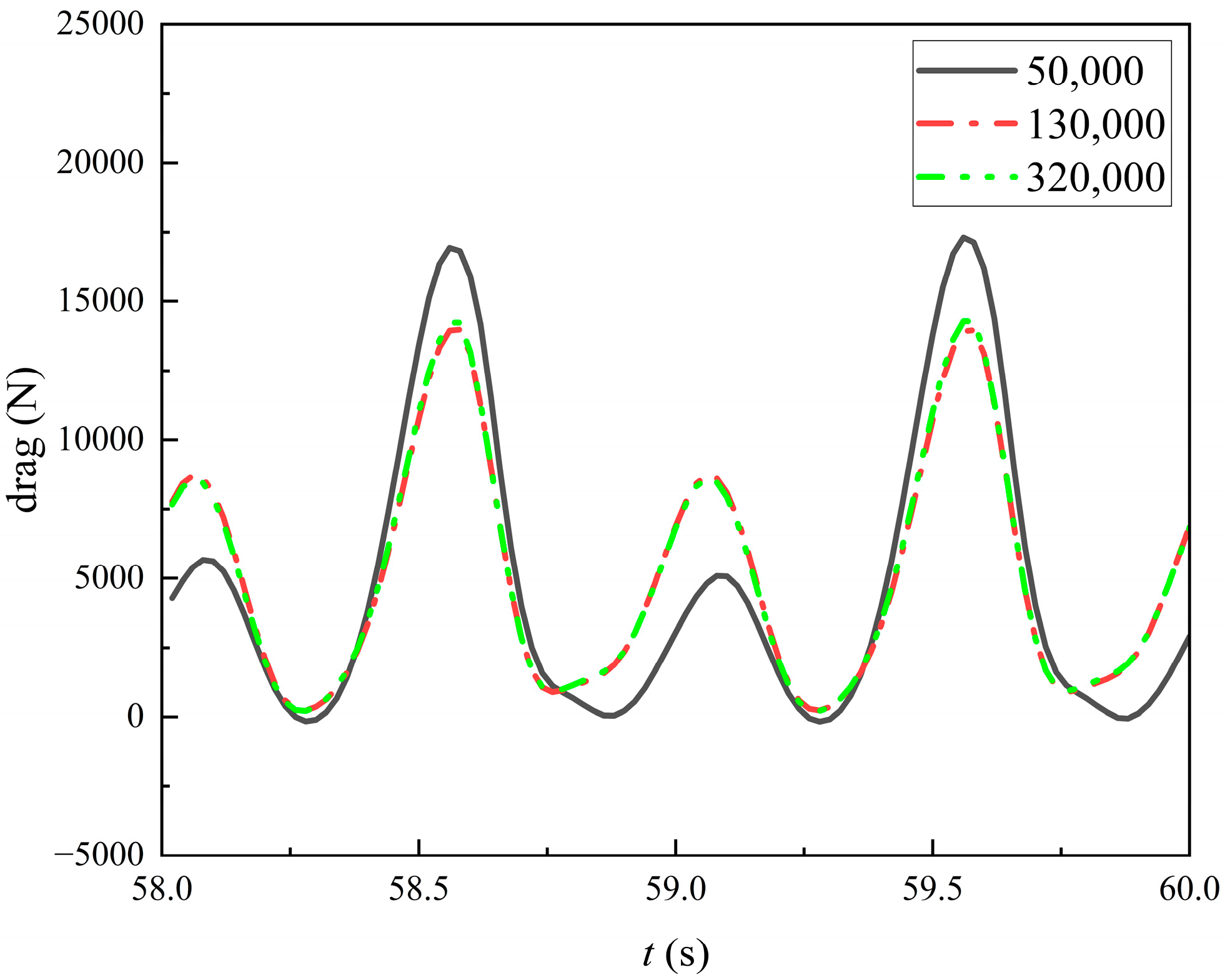
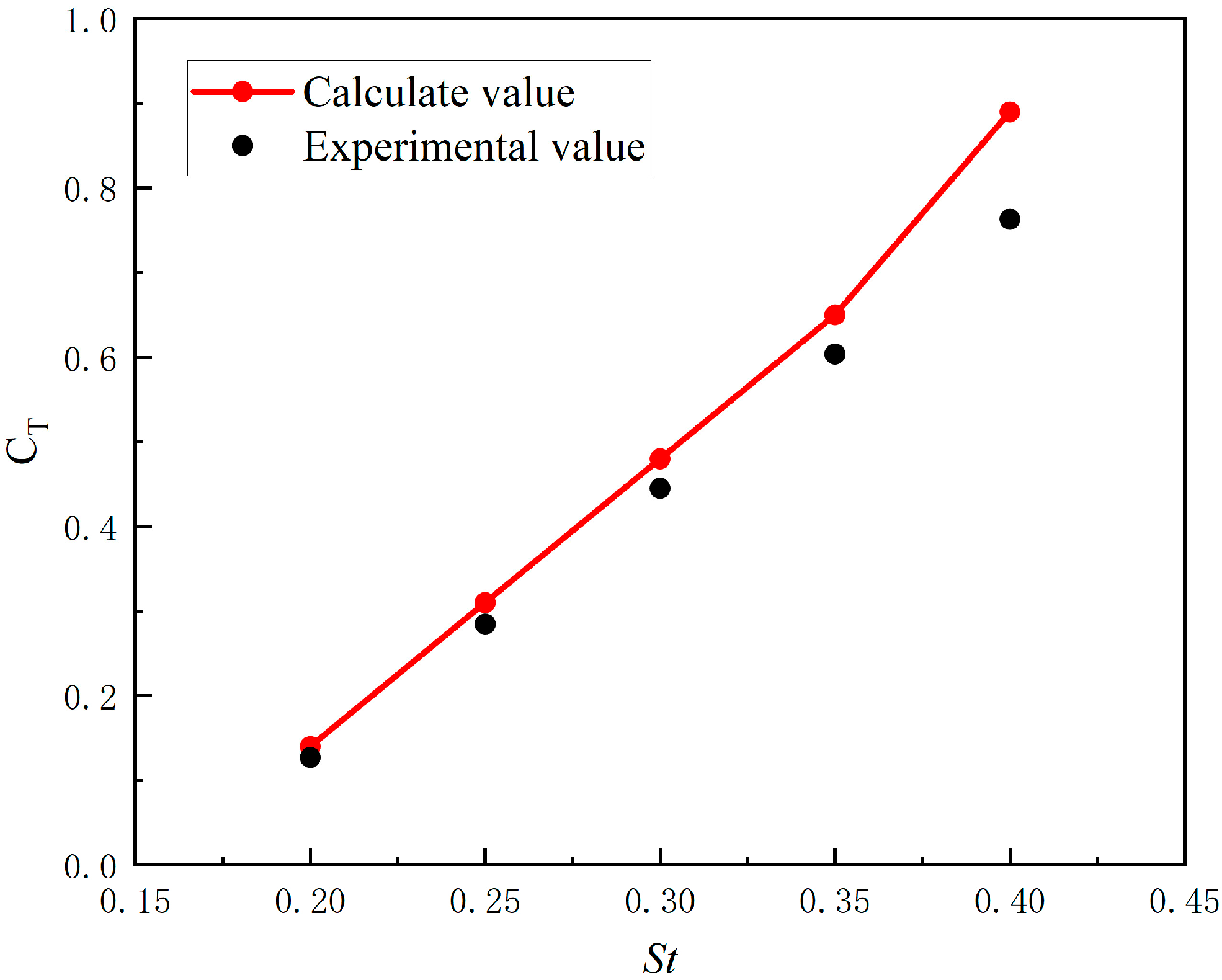
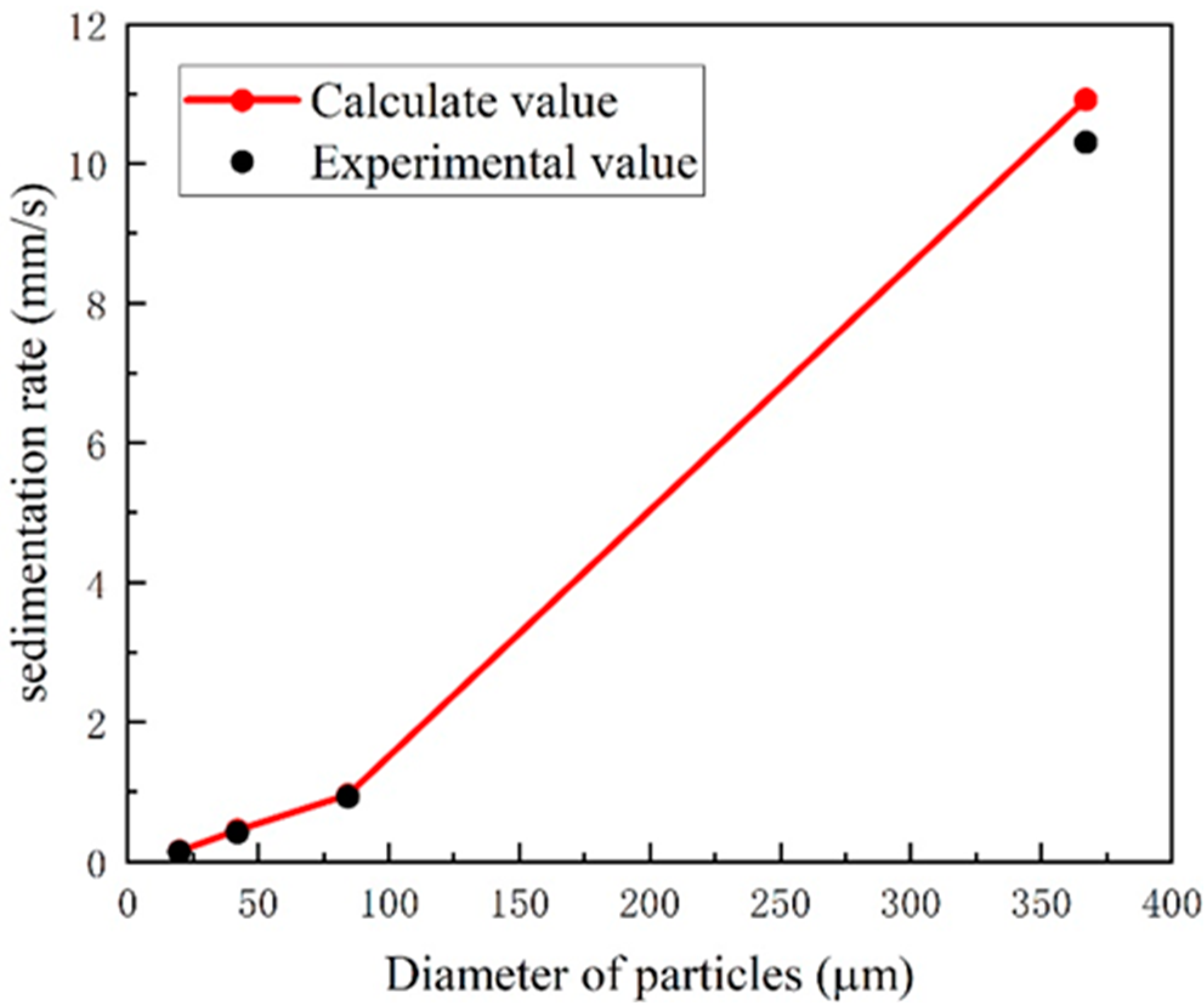


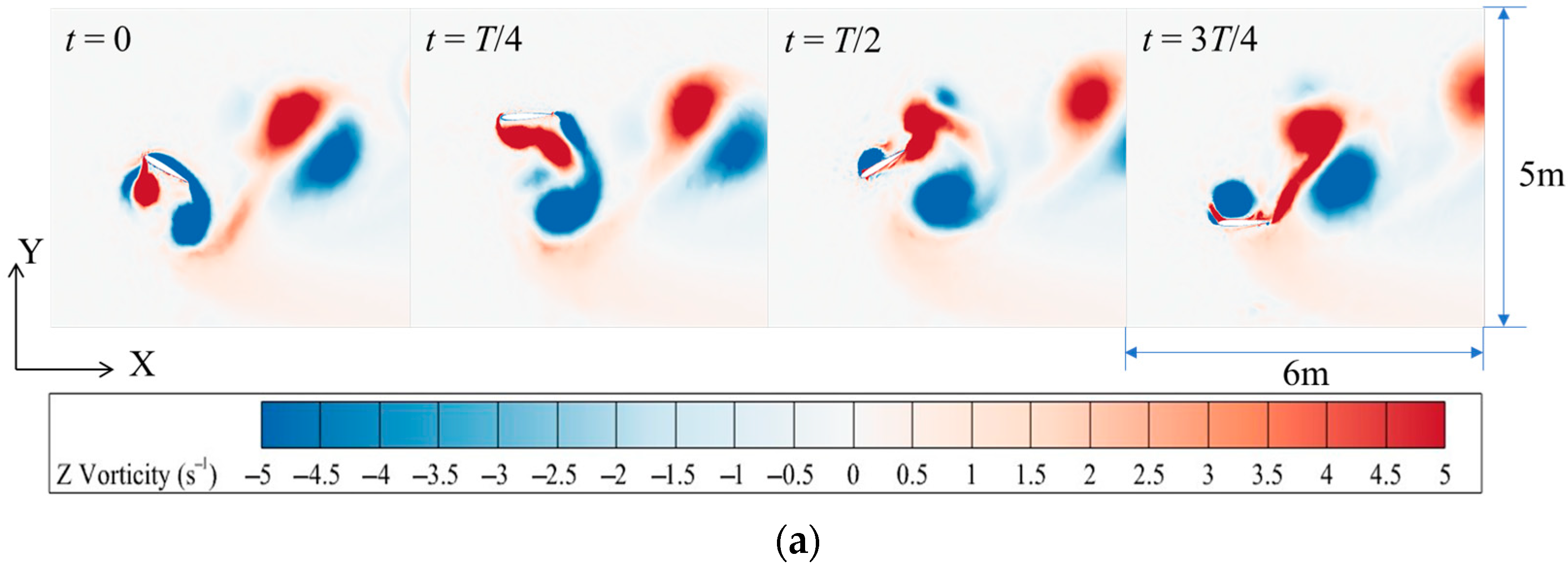


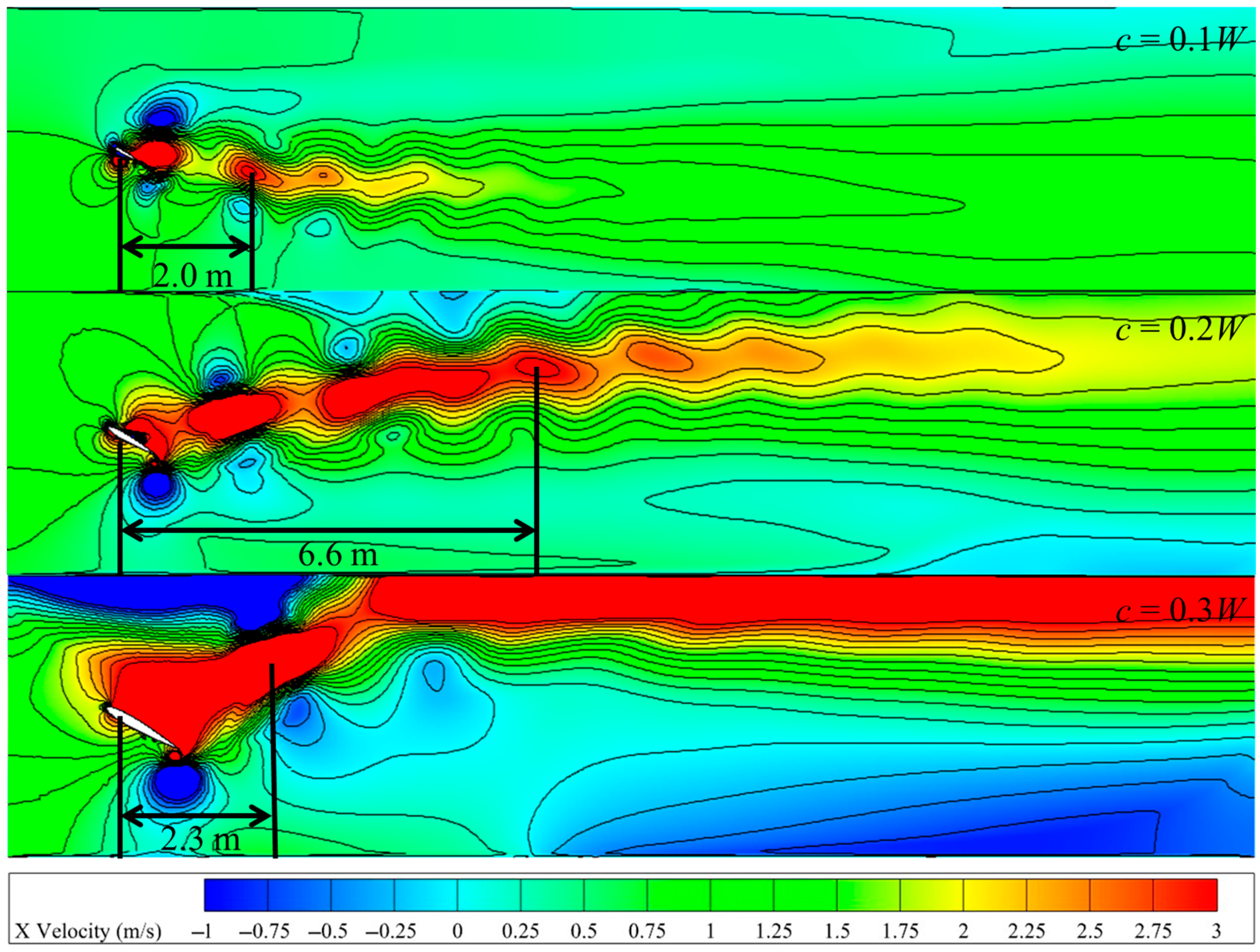
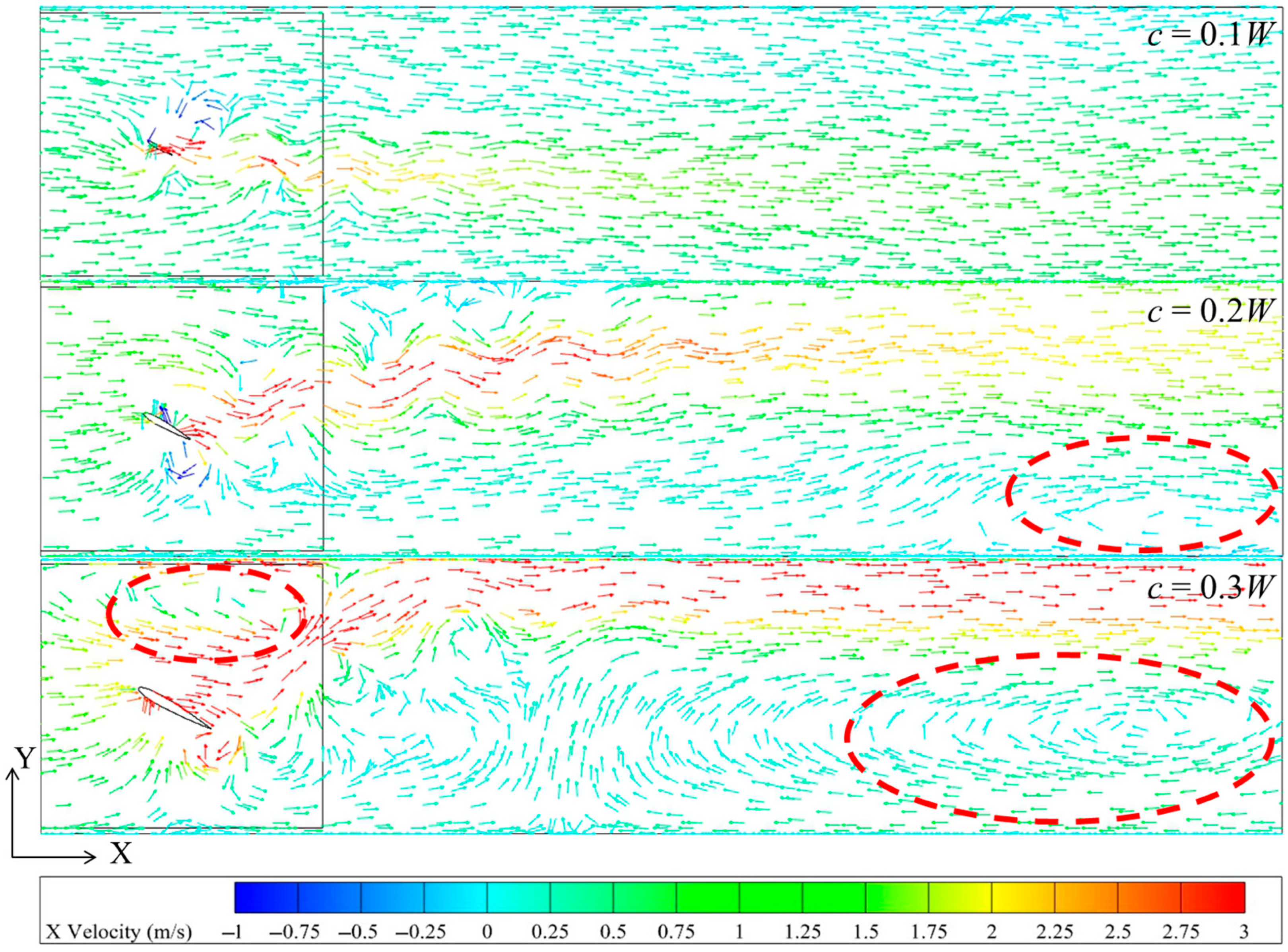
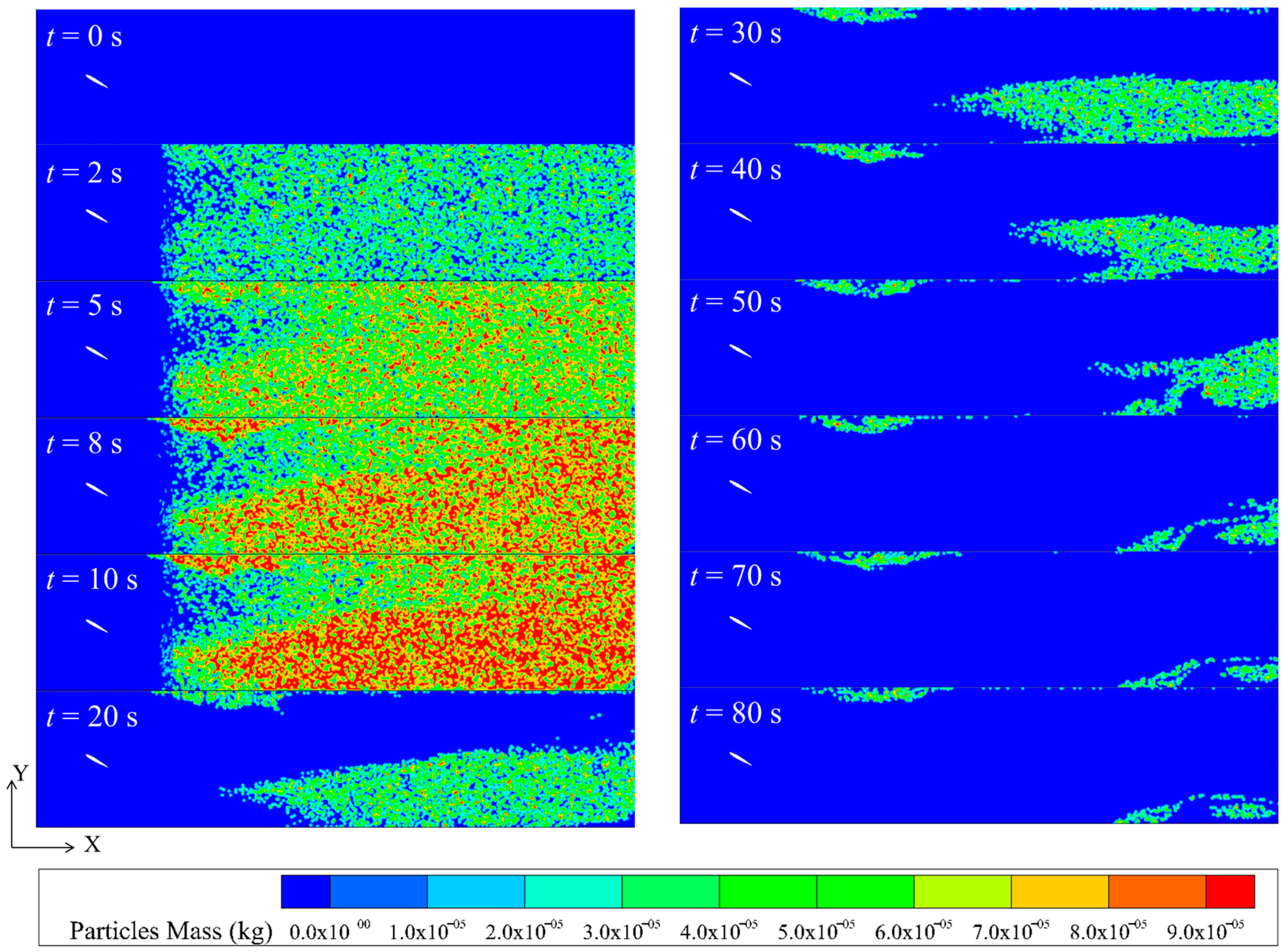

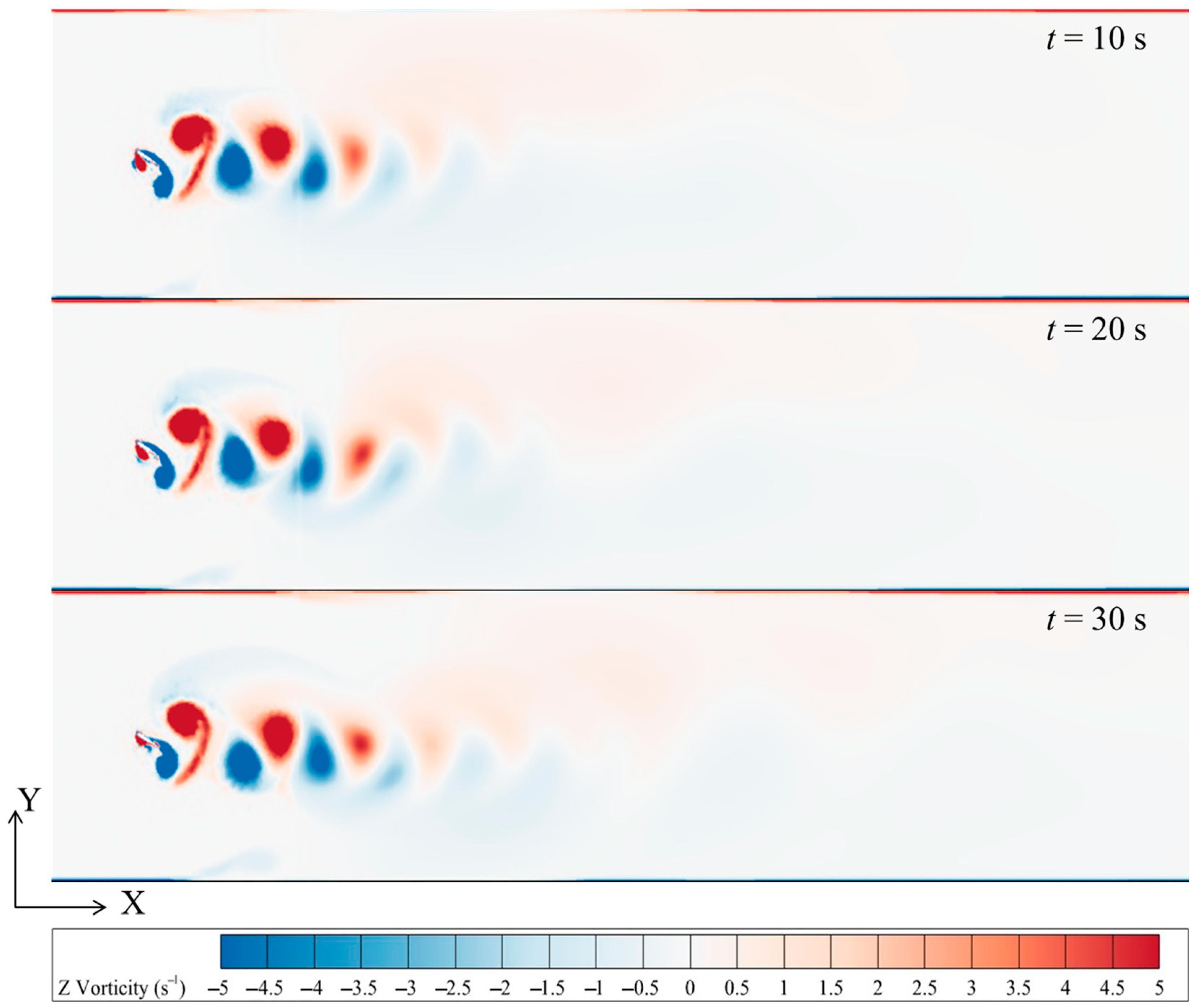
| Frequency (Hz) | Chord Length | ||
|---|---|---|---|
| 0.1 W | 0.2 W | 0.3 W | |
| 0.5 | 0.397 | 0.001 | 0.047 |
| 0.6 | 0.458 | 0.209 | 0.053 |
| 0.7 | 0.396 | 0.214 | 0.051 |
| 0.8 | 0.396 | 0.213 | 0.062 |
| 0.9 | 0.418 | 0.202 | 0.071 |
| 1.0 | 0.420 | 0.212 | 0.081 |
| Frequency (Hz) | Chord Length | ||
|---|---|---|---|
| 0.1 W | 0.2 W | 0.3 W | |
| 0.5 | 0.357 | 0.338 | 0.481 |
| 0.6 | 0.470 | 0.621 | 0.576 |
| 0.7 | 0.512 | 0.726 | 0.668 |
| 0.8 | 0.601 | 0.827 | 0.756 |
| 0.9 | 0.691 | 0.925 | 0.839 |
| 1.0 | 0.765 | 1.042 | 0.916 |
Disclaimer/Publisher’s Note: The statements, opinions and data contained in all publications are solely those of the individual author(s) and contributor(s) and not of MDPI and/or the editor(s). MDPI and/or the editor(s) disclaim responsibility for any injury to people or property resulting from any ideas, methods, instructions or products referred to in the content. |
© 2024 by the authors. Licensee MDPI, Basel, Switzerland. This article is an open access article distributed under the terms and conditions of the Creative Commons Attribution (CC BY) license (https://creativecommons.org/licenses/by/4.0/).
Share and Cite
Hua, E.; Wang, T.; Xiang, M.; Lu, C.; Song, Y.; Sun, Q. Study on the Influence of Chord Length and Frequency of Hydrofoil Device on the Discharge Characteristics of Floating Matter in Raceway Aquaculture. J. Mar. Sci. Eng. 2024, 12, 1584. https://doi.org/10.3390/jmse12091584
Hua E, Wang T, Xiang M, Lu C, Song Y, Sun Q. Study on the Influence of Chord Length and Frequency of Hydrofoil Device on the Discharge Characteristics of Floating Matter in Raceway Aquaculture. Journal of Marine Science and Engineering. 2024; 12(9):1584. https://doi.org/10.3390/jmse12091584
Chicago/Turabian StyleHua, Ertian, Tao Wang, Mingwang Xiang, Caiju Lu, Yabo Song, and Qizong Sun. 2024. "Study on the Influence of Chord Length and Frequency of Hydrofoil Device on the Discharge Characteristics of Floating Matter in Raceway Aquaculture" Journal of Marine Science and Engineering 12, no. 9: 1584. https://doi.org/10.3390/jmse12091584
APA StyleHua, E., Wang, T., Xiang, M., Lu, C., Song, Y., & Sun, Q. (2024). Study on the Influence of Chord Length and Frequency of Hydrofoil Device on the Discharge Characteristics of Floating Matter in Raceway Aquaculture. Journal of Marine Science and Engineering, 12(9), 1584. https://doi.org/10.3390/jmse12091584




